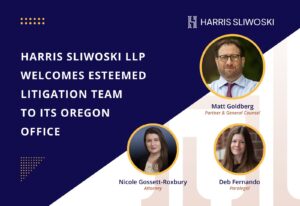With the SEC v. Ripple decision emerging recently, many commentators (see here and here) have focused on the holding of the case, which is the correct place to start. This post focuses on the holding, plus additional matters discussed in the decision and additional insights gleaned from the rest of the decision.
Foundational Facts of the Ripple Decision
Many blockchain founders wrestle with the same questions to try to insulate the founders from the project’s actual and potential liabilities, including regulatory issues with the SEC and other regulators. These initial questions are:
- Should we issue a token?
- What should our token’s functionality be?
- How many entities do we need?
- What types of entities do we need?
- Which entities should hold which parts of the venture?
The XRP founders were ambitious early adopters, seeking to improve and replace Bitcoin starting around 2012. They began by developing the XRP ledger smart contract protocols, which they used to mint the XRP tokens. The founders kept 20% of the minted tokens and contributed the remaining 80% to the Ripple Labs entity. Ripple Labs then created the software to facilitate cross-border currency transactions.
It is not clear from the decision who retained control of the private keys to the XRP ledger, but it is clear that Ripple Labs did not have control of the ledger. And Bradley Garlinghouse and Christian Larsen believed that they could avoid the “common enterprise” prong of the Howey test by keeping the XRP smart contract protocols separate from Ripple Labs. The establishment of a firewall is a common, if not the most common, conversation in the blockchain legal space.
Comments on the Ripple Holding
For those who are not familiar with the Howey test, it is the Supreme Court’s preeminent test of what constitutes a security (or an investment contract, which is a type of security). There are four prongs to the Howey test:
- An investment of money or other consideration
- In a common enterprise
- With the expectation of profits
- Derived solely from the efforts of others.
If you are at all familiar with the workings of common law, you know that each of those words in the Howey test has been expanded on in subsequent cases since the original decision was issued.
The court found that Ripple sold and distributed XRP in three situations. The first was direct sales or institutional sales to typical institutional investors like hedge funds and on-demand liquidity providers. The court held that these direct sales violated the Securities Act because Ripple did not file any registration statements in conjunction with these sales. I find Ripple’s actions strange because even if the Ripple team didn’t want to undergo a full registration surrounding the issuance and sale of XRP, they likely could have availed themselves of one or more exemptions from registration, at least in the early stages of the venture. I assume their competent lawyers recommended this course of action to them in the memos cited in the decision.
The second holding surrounded Ripple’s programmatic sales via trading algorithms on decentralized exchanges (DEXs). The court sided with Ripple, holding that these sales did not constitute the sale of securities because the blind sales did not constitute an investment in Ripple with the expectation of profits. This is interesting mainly because of the DEX component to the analysis. Every crypto company with a token wants it to be traded on the foremost DEXs, many of which are not regulated. The court did not touch on this aspect of DEXs or whether the secondary sales that occur on these DEXs would constitute a sale of securities.
And the third situation involved other distributions of XRP to Ripple employees as part of their compensation or as grants or bounties to key partners to encourage them to build the XRP ecosystem. None of these scenarios were deemed to be an investment of money or other consideration in Ripple. These two scenarios affirm a safe harbor for crypto projects, many of which are using their tokens as a form of compensation or related incentive. While these are relatively straightforward and obvious uses of XRP, it is good to see these use cases confirmed by the court.
What Can We Extrapolate from the Ripple Decision?
There are many takeaways that are not clearly within the scope of the holding but are still instructive to consider.
1. Typical ICOs/IEOs and similar activities will likely be seen as securities issuances.
2. The SEC is not backing down and will certainly appeal the decision, either now or after the remaining non-summary judgment issues are resolved by the court. It will take many months or years if this gets appealed to the Supreme Court, after an appeal to the Second Circuit Court of Appeals.
3. Blockchain projects with a token should consider whether, on balance, their token will be seen from the outside as either desirable for investment or necessary for consumption in their business model. These are the two big categories to parse until we receive more nuance in future judicial decisions.
4. Founding teams should carefully consider what type of messaging they and their marketing materials are sending to potential participants and regulators. Courts will look far beyond your marketing materials into the “economic reality and totality of circumstances” surrounding your token. A written contract is not required for the sale of a security. The court noted that the inquiry will look at the promises and offers made to investors rather than each individual participant’s motives, including how broadly the marketing materials were disseminated in the marketplace.
5. It is likely possible to sell tokens as commodities rather than as securities, depending on their character.
6. If you fail one prong of the Howey test, your token will not be considered a security. I am especially focused on prong 4 of the Howey test as the best place for blockchain projects to note. For example, DAOs (decentralized autonomous organizations) provide a new kind of model where hundreds or thousands of people can participate together, potentially negating the “derived solely from the efforts of others” criteria. We do not yet have guidance regarding how involved each token holder would need to be or at what stage of the venture they would need to join to be considered a founder or substantially participate in the overall operations.
7. Aiding and abetting a securities violation is a big deal, and no founding team wants to be in this position. Getting an opinion from a law firm may help in determining whether the founders’ decisions were reasonable or a willful violation of the Securities Act. Recklessly disregarding applicable laws and regulations will not be a defense for founders.
8. It may be possible to put some tokens into the marketplace without engaging in an IPO/ICO, providing a market for secondary sales in a compliant way. Ripple gave some XRP to early adopters and developers, charities, and grant recipients. This may not make economic sense for some projects, but for others, it might.
9. We still do not know the status of non-registered DEXs and whether a non-registered DEX would taint all tokens listed on that exchange.
10. We do not know how far the courts will stretch the definition of a “common enterprise” in this new decentralized world.
This decision is certainly a long-awaited for watershed moment in web3, but there remains plenty to be settled beyond the headlines.
For more information, see:
Is Web3 Dead? Not From Where We Are Sitting
Which Industries Can Benefit from Smart Contracts?
Are Smart Contracts Legal Contracts?

























